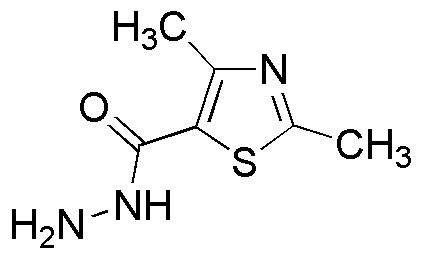2,4-Dimethyl-thiazole-5-carboxylic acid hydrazide is widely utilized in research focused on:
- Agricultural Chemistry: This compound serves as a key intermediate in the synthesis of agrochemicals, particularly fungicides and herbicides, enhancing crop protection and yield.
- Pharmaceutical Development: It is explored for its potential in drug formulations, particularly in the development of new antimicrobial agents, addressing the growing need for effective treatments against resistant pathogens.
- Material Science: The compound is used in the creation of specialty polymers and coatings, providing improved durability and resistance to environmental factors, which is essential in various industrial applications.
- Analytical Chemistry: It acts as a reagent in analytical methods to detect and quantify specific metal ions, aiding researchers in environmental monitoring and quality control processes.
- Food Industry: This chemical is investigated for its potential as a food preservative, offering a natural alternative to synthetic preservatives while maintaining food safety and extending shelf life.
General Information
Properties
Safety and Regulations
Applications
2,4-Dimethyl-thiazole-5-carboxylic acid hydrazide is widely utilized in research focused on:
- Agricultural Chemistry: This compound serves as a key intermediate in the synthesis of agrochemicals, particularly fungicides and herbicides, enhancing crop protection and yield.
- Pharmaceutical Development: It is explored for its potential in drug formulations, particularly in the development of new antimicrobial agents, addressing the growing need for effective treatments against resistant pathogens.
- Material Science: The compound is used in the creation of specialty polymers and coatings, providing improved durability and resistance to environmental factors, which is essential in various industrial applications.
- Analytical Chemistry: It acts as a reagent in analytical methods to detect and quantify specific metal ions, aiding researchers in environmental monitoring and quality control processes.
- Food Industry: This chemical is investigated for its potential as a food preservative, offering a natural alternative to synthetic preservatives while maintaining food safety and extending shelf life.
Documents
Safety Data Sheets (SDS)
The SDS provides comprehensive safety information on handling, storage, and disposal of the product.
Product Specification (PS)
The PS provides a comprehensive breakdown of the product’s properties, including chemical composition, physical state, purity, and storage requirements. It also details acceptable quality ranges and the product's intended applications.
Certificates of Analysis (COA)
Search for Certificates of Analysis (COA) by entering the products Lot Number. Lot and Batch Numbers can be found on a product’s label following the words ‘Lot’ or ‘Batch’.
Numéro de catalogue
Numéro de lot/série
Certificates Of Origin (COO)
This COO confirms the country where the product was manufactured, and also details the materials and components used in it and whether it is derived from natural, synthetic, or other specific sources. This certificate may be required for customs, trade, and regulatory compliance.
Numéro de catalogue
Numéro de lot/série
Safety Data Sheets (SDS)
The SDS provides comprehensive safety information on handling, storage, and disposal of the product.
DownloadProduct Specification (PS)
The PS provides a comprehensive breakdown of the product’s properties, including chemical composition, physical state, purity, and storage requirements. It also details acceptable quality ranges and the product's intended applications.
DownloadCertificates of Analysis (COA)
Search for Certificates of Analysis (COA) by entering the products Lot Number. Lot and Batch Numbers can be found on a product’s label following the words ‘Lot’ or ‘Batch’.
Numéro de catalogue
Numéro de lot/série
Certificates Of Origin (COO)
This COO confirms the country where the product was manufactured, and also details the materials and components used in it and whether it is derived from natural, synthetic, or other specific sources. This certificate may be required for customs, trade, and regulatory compliance.


